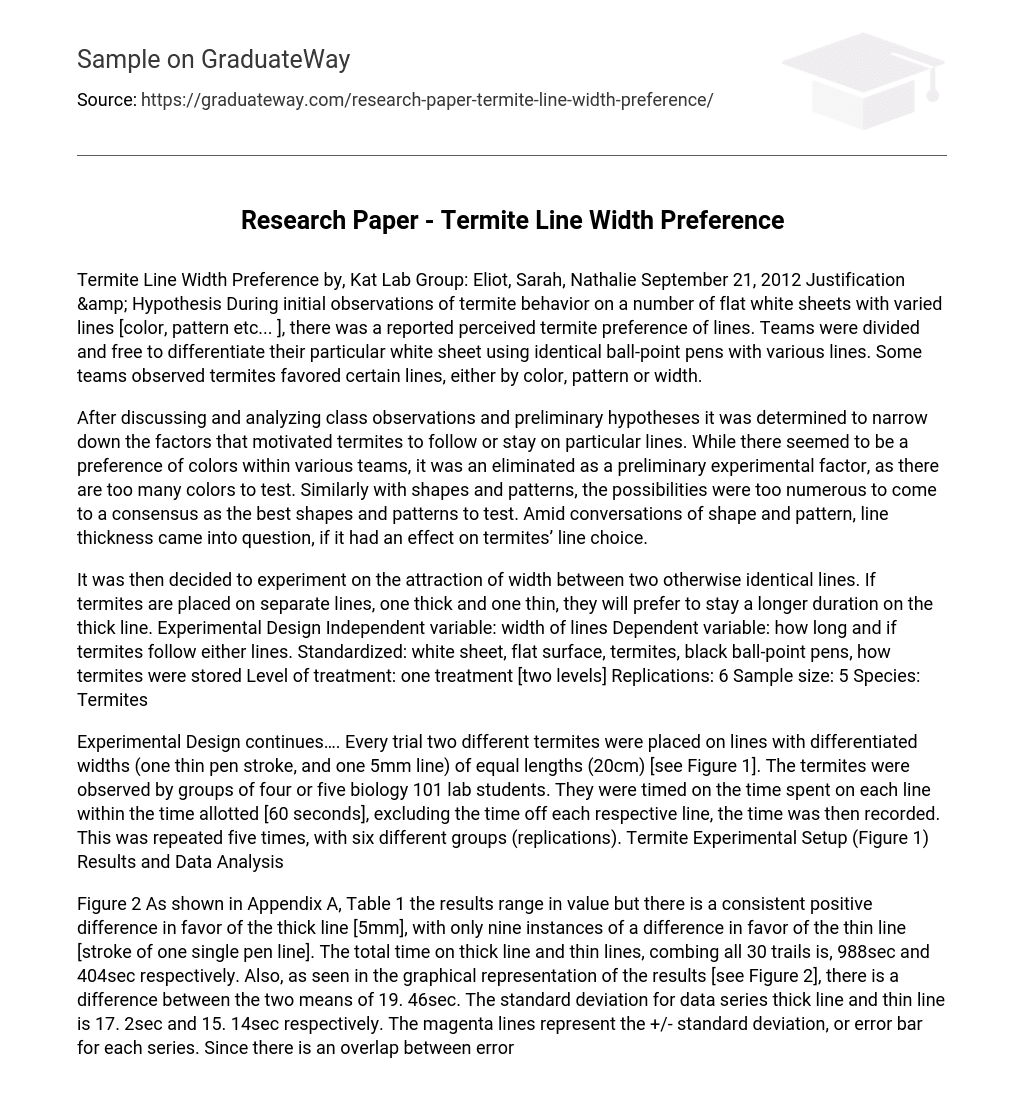Termite Line Width Preference by, Kat Lab Group: Eliot, Sarah, Nathalie September 21, 2012 Justification & Hypothesis During initial observations of termite behavior on a number of flat white sheets with varied lines [color, pattern etc… ], there was a reported perceived termite preference of lines. Teams were divided and free to differentiate their particular white sheet using identical ball-point pens with various lines. Some teams observed termites favored certain lines, either by color, pattern or width.
After discussing and analyzing class observations and preliminary hypotheses it was determined to narrow down the factors that motivated termites to follow or stay on particular lines. While there seemed to be a preference of colors within various teams, it was an eliminated as a preliminary experimental factor, as there are too many colors to test. Similarly with shapes and patterns, the possibilities were too numerous to come to a consensus as the best shapes and patterns to test. Amid conversations of shape and pattern, line thickness came into question, if it had an effect on termites’ line choice.
It was then decided to experiment on the attraction of width between two otherwise identical lines. If termites are placed on separate lines, one thick and one thin, they will prefer to stay a longer duration on the thick line. Experimental Design Independent variable: width of lines Dependent variable: how long and if termites follow either lines. Standardized: white sheet, flat surface, termites, black ball-point pens, how termites were stored Level of treatment: one treatment [two levels] Replications: 6 Sample size: 5 Species: Termites
Experimental Design continues…. Every trial two different termites were placed on lines with differentiated widths (one thin pen stroke, and one 5mm line) of equal lengths (20cm) [see Figure 1]. The termites were observed by groups of four or five biology 101 lab students. They were timed on the time spent on each line within the time allotted [60 seconds], excluding the time off each respective line, the time was then recorded. This was repeated five times, with six different groups (replications). Termite Experimental Setup (Figure 1) Results and Data Analysis
Figure 2 As shown in Appendix A, Table 1 the results range in value but there is a consistent positive difference in favor of the thick line [5mm], with only nine instances of a difference in favor of the thin line [stroke of one single pen line]. The total time on thick line and thin lines, combing all 30 trails is, 988sec and 404sec respectively. Also, as seen in the graphical representation of the results [see Figure 2], there is a difference between the two means of 19. 46sec. The standard deviation for data series thick line and thin line is 17. 2sec and 15. 14sec respectively. The magenta lines represent the +/- standard deviation, or error bar for each series. Since there is an overlap between error bars, it is recommended to perform a t-test to ensure the data is distinct from each other and merely not by chance. Using the available information the degree of freedom is calculated at 58, which gives a critical t-value of 1. 67 at 95% confidence level. The t-value for the data range calculated is 2. 845 which is significantly greater than the critical t-value.
Therefore there is a very low probability the two sets of data and means overlap, giving a 5% probability the results are due to chance. P –value is less than 0. 05. Discussion and Conclusions The mean of both independent variables suggest there is a greater length of time overall spent on the thicker line than on the thin line. The standard deviations for both lines substantiate a high probability of a normal distribution; greatly reducing the possibility of extreme values for either data series and skewing results.
Since the t-value is much greater than the critical t-value it can be deduced the null hypothesis can be rejected, and the alternative hypothesis is possible. According to the results, on Table 1 and its graphical representation Figure 2, it appears termites spent a total of more time on the thick line than the thin line, as well as on average. However, while line width can be the cause of termite preference, it does not strongly support the idea termites are attracted to thicker lines for their sole characteristic of measured width.
It is possible the thicker lines have a stronger scent of the chemical used to synthesize ink and therefore has a stronger attraction for termites, or thicker lines could have a heavier indentation on the white sheet surface that attracts termites. Further investigation of termite’s natural habit and current accepted scientific data on their behavior is required to place results in context, and determine if any and which factors should be further tested. Appendix A Table 1 (Values are in seconds)





